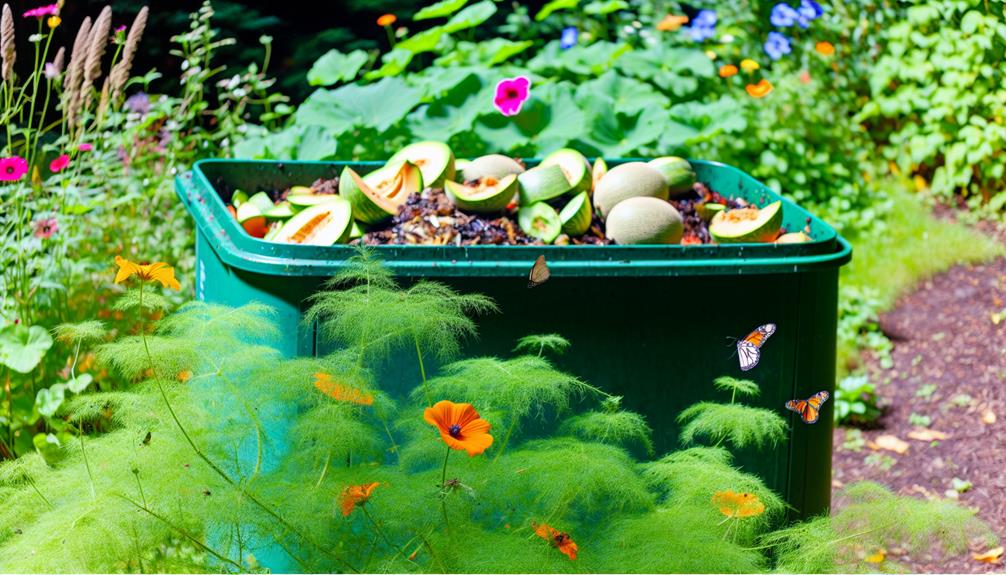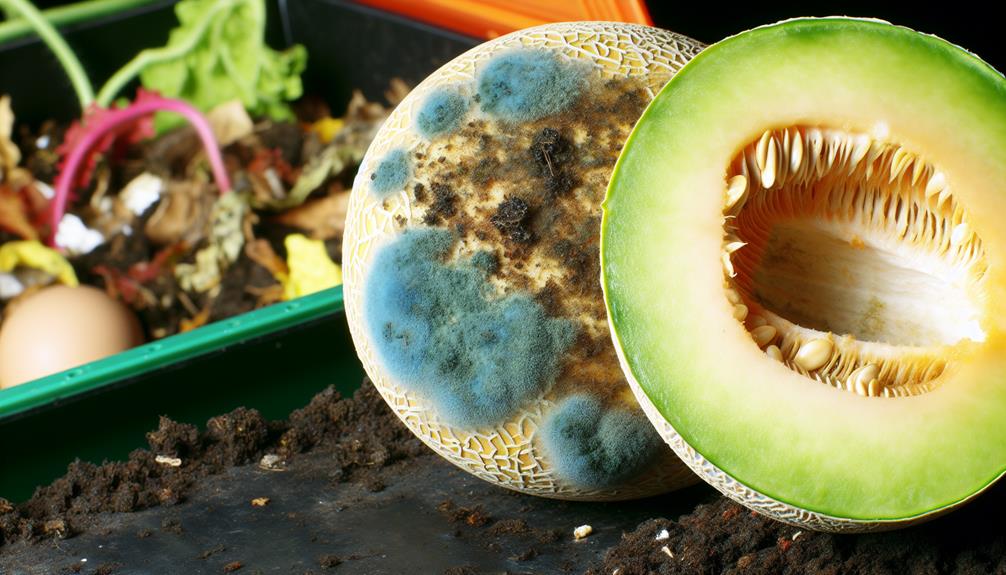

Yes, you can absolutely compost cantaloupe! By delving into composting cantaloupe, you enrich your soil with essential nutrients like potassium, boost soil structure, and help plants grow healthier. To get started, cut the cantaloupe into smaller pieces, removing seeds to prevent unwanted sprouting.
Mix these with both green materials, like fruit peels, and brown ones, like dried leaves, to keep your compost balanced. Managing moisture and regularly turning your pile will guarantee efficient decomposition. Even moldy cantaloupe can supercharge your compost’s nutrient content! Immerse yourself in these steps to transform your kitchen scraps into garden gold.
When you compost cantaloupe, you’re not just reducing waste—you’re enriching your soil with essential nutrients like potassium and Vitamin A. These nutrients are crucial for healthy plant growth, improving everything from root development to disease resistance.
By adding cantaloupe to your compost, you’ll boost the soil’s potassium levels, which are essential for robust plant growth. Potassium is a key nutrient that not only enhances soil structure but also improves moisture retention, making it perfect for fostering healthy plants.
When cantaloupe decomposes, it releases potassium, enriching the compost and, eventually, your garden soil. This nutrient supports crucial plant functions, ensuring your garden flourishes with vibrant, strong plants.
Including cantaloupe in your compost also helps reduce organic waste, contributing to a more sustainable environment. Join the community of eco-friendly gardeners by composting cantaloupe and nurturing your plants with the potassium they need. Your garden will thank you for it!
Adding cantaloupe to your compost enriches the soil with Vitamin A, a nutrient essential for vision health and immune function. When you toss in cantaloupe rinds and seeds, they break down and release Vitamin A, which promotes healthy skin, tissue repair, and cell growth in your plants.
This nutrient boost from the cantaloupe helps in developing strong, vibrant plants.
Including these nutrient-rich rinds in your compost not only enhances soil fertility but also supports your garden’s overall growth. By composting cantaloupe, you’re creating a healthier environment for your plants, ensuring they get the best nutrients to thrive.
Also Raed: Can You Compost Basil?
Composting cantaloupe scraps effectively reduces the amount of organic waste that ends up in landfills. By turning kitchen scraps like cantaloupe rinds into compost, you’re not only conserving landfill space but also minimizing methane gas emissions, which helps combat climate change. Composting transforms waste into a valuable resource, returning essential nutrients to the soil and promoting sustainability in agriculture.

| Benefit | Impact |
|---|---|
| Conserves landfill space | Reduces organic waste volume |
| Minimizes methane emissions | Helps combat climate change |
| Enriches soil nutrients | Promotes sustainable agriculture |
When preparing cantaloupe for your compost, start by cutting it into smaller pieces, which helps it break down faster.
Make sure to clean the rind thoroughly to remove any pesticides or chemicals, as these can harm your compost.
Also, remember to remove the seeds, since they mightn’t decompose well and could sprout unwanted plants in your garden.
To prepare cantaloupe rinds for composting, rinse them under cold water to remove dirt and debris. Use a vegetable scrub brush to gently clean the surface of the rind. This step is important for avoiding contamination in your compost pile.
Remove any visible dirt or residue, ensuring that your compost remains healthy and effective. Don’t forget to cut off any damaged or spoiled areas of the rind to maintain the quality of your compost.
Properly cleaned cantaloupe rinds can be chopped into smaller pieces, which will decompose faster and enrich your compost pile with valuable nutrients. Embrace this eco-friendly practice, and feel great about contributing to a sustainable environment!
Extracting the seeds from a cantaloupe is crucial to prevent unwanted sprouting in your compost pile. Cantaloupe seeds may not decompose fully, leading to possible germination, which can disrupt your composting efforts. By removing the seeds, you guarantee a smoother and more efficient decomposition process.
Carefully scoop out the cantaloupe seeds with a spoon before adding the flesh and rind to your compost bin. This small step speeds up the breakdown of organic material and avoids any unexpected growth. Seedless cantaloupe scraps are ideal for composting, helping you maintain a clean, thriving compost pile.
Embrace this practice and watch your compost transform into rich, fertile soil without any pesky surprises!
Achieving harmony in your compost pile requires a careful mix of green and brown materials. Composting cantaloupe scraps means you’re adding nitrogen-rich green materials, which are essential for efficient decomposition. To balance your pile, aim for a 1:2 ratio of green to brown materials. This combination supports microbial activity and the breakdown of organic matter, ensuring your compost is nutrient-rich and odor-free.
Here’s what you can add to balance your compost pile:
To keep your compost pile healthy and efficient, you’ll need to focus on maintaining the right moisture levels and temperature. Ensuring the pile is moist but not soggy will promote the breakdown of cantaloupe rinds and other materials. Additionally, regulating the temperature by turning the pile regularly will create an ideal environment for decomposition.
Maintaining ideal moisture levels between 50-60% is crucial for effective decomposition of cantaloupe in your compost pile. Too much moisture can make the pile soggy, while too little slows down decomposition. You’ll want to monitor and adjust moisture to keep things just right.
Here’s how you can guarantee your compost stays in the sweet spot:
Now that you’ve got the moisture levels under control, let’s focus on keeping your compost pile at the right temperature. Temperature control is essential for efficient decomposition of cantaloupe.
Aim to maintain your pile between 110-160°F; this range helps thermophilic bacteria thrive, breaking down organic matter faster. Fluctuating temperatures can slow down the process, so regularly monitor the pile with a compost thermometer.
By ensuring consistent heat, you’ll prevent pathogens and weed seeds from surviving, creating safer compost. Remember, temperature control isn’t just about speed—it’s about fostering a healthy community within your compost that works together to break down your cantaloupe effectively.
Keep checking those temperatures, and you’ll see great results!
Also Raed: Can You Compost Baking Soda?
When composting cantaloupe, you’ll find that the seeds can be particularly stubborn and slow to decompose. Adding cantaloupe to your compost pile is generally a great idea, but the seeds pose a unique challenge.
They’ve a tough outer shell and can even sprout unexpectedly. To keep your compost pile thriving and avoid these issues, consider these tips:
Cantaloupe rinds can take several months to decompose fully, especially if not cut into smaller pieces. To speed up the process, chop the rinds into 2-inch chunks. This makes it easier for microorganisms to break them down, enriching your compost with valuable nutrients.
The phosphorus from cantaloupe rinds plays a crucial role in creating rich soil, perfect for nourishing future plants. Be patient and let nature do its work. You’ll know it’s ready when the compost turns dark, rich, and has that wonderful earthy smell.
Also Raed: Can You Compost Alfalfa Sprouts?
Don’t toss out moldy cantaloupe; composting it can actually enhance your compost pile’s nutrient content. Mold on cantaloupe signals decomposition, which releases valuable nutrients, enriching your compost with organic matter. By adding moldy cantaloupe, you’re contributing to a nutrient-rich compost pile that benefits plant growth.

Proper management is key, so be sure to monitor for any excessive mold growth. Here are some reasons why you should compost moldy cantaloupe:
To maximize the benefits of composting moldy cantaloupe, follow these practical composting tips for a thriving compost pile.
First, cut the cantaloupe into smaller pieces to speed up decomposition.
Next, balance your compost with green and brown materials. Add dry leaves, straw, or shredded paper to maintain the nitrogen balance from the cantaloupe.
Keep your compost pile moist, but not waterlogged, to support the microbes breaking down the materials.
Regularly turning the pile is essential to guarantee proper aeration and decomposition.
You shouldn’t add dairy, meat, fish, or greasy foods to your compost. They attract pests and create odors. Also, limit citrus peels and avoid pet waste due to harmful pathogens. Keep your compost healthy and balanced!
You shouldn’t compost citrus fruits, pineapple scraps, avocado pits, large seeds, and mango skins due to their slow decomposition and pest attraction. Bury banana peels deep to avoid fruit flies. Stick to easily compostable fruits for best results.
Yes, you can put bad fruit in compost, but avoid moldy or rotten ones. Add in moderation to prevent pests and odors. Properly decomposed bad fruit still contributes valuable nutrients, helping your compost thrive.
Yes, melons are great for compost. They add essential nutrients like potassium and phosphorus, enriching your soil. Just remember to avoid adding seeds, and you’ll contribute to a more sustainable environment by reducing organic waste.
Composting cantaloupe is a fantastic way to enrich your garden, reduce waste, and nourish your soil with essential nutrients.
By properly preparing and balancing your compost pile, you guarantee efficient decomposition. Even moldy cantaloupe and seeds can be composted, contributing valuable organic matter.
Remember to monitor your pile for moisture and aeration, and soon, you’ll have rich compost ready to boost your plants’ growth.
Engage in composting cantaloupe, and watch your garden thrive!
